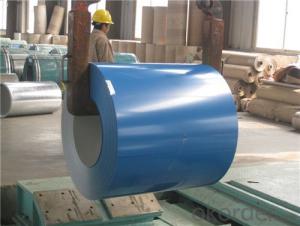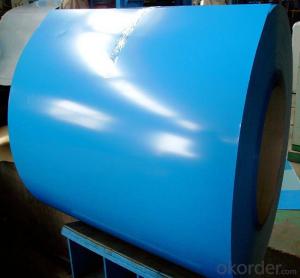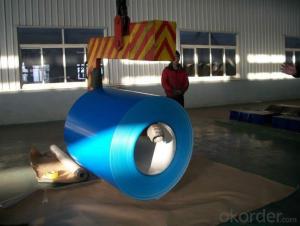Z20 BMP Prepainted Rolled Steel Coil for Construction
- Loading Port:
- Shanghai
- Payment Terms:
- TT OR LC
- Min Order Qty:
- 100 m.t.
- Supply Capability:
- 30000 m.t./month
OKorder Service Pledge
OKorder Financial Service
You Might Also Like
Structure of Z20 BMP Prepainted Rolled Steel Coil for Construction

Description of Z20 BMP Prepainted Rolled Steel Coil for Construction
EN 10147 Structure hot dip galvanized steel coil S250GD+Z, S350GD+Z (SGC340, SS275, SS340)/Custom Deep drawing hot dip galvanized steel coil DX52D+Z, DX53D+Z, S
Galvanized steel is taken cold rolled steel as the base metal, after continuous hot dip galvanizing process, the product produced is an excellent resistance to atmospheric corrosion coating steel coil, as the steel gets coated in layers of zinc and rust won't attach this protective metal; Cold rolled plate by hot-dip galvanizing may extend the service life of 15-20 years.
For countless outdoor, marine, or industrial applications, galvanized steel is an essential fabrication component. Hot dip galvanized steel is used in applications where steel may be exposed to weather, but where stainless steel is too expensive.

Main Feature of Z20 BMP Prepainted Rolled Steel Coil for Construction
Galvanized steel sheet(include HDG and EG)
With the features of good corrosion resistance, the products are mainly used in automobile, home appliance, electronics, building and machinery manufacture industries, etc.
Precoated steel sheet
With the features of enviromental protection and good processablility, long lasting surface durability, rich in colors, the products are maily used in building, home appliance and furniture industries, etc.
Electrical steel sheet
Mainly used to manufacture generating equipment, locomotive, industrial motor and home appliance.
Applications of Z20 BMP PPGI Prepainted Rolled Steel Coil for Construction
Construction
Manufacture anticorrosion, industrial and civil architecture roof boarding, roof grille
Light industries
Home appliance's case, civil chimney, kitchen utensils
Auto industry
Corrosion resistant parts of cars
Agriculture
Food storage, meat and aquatic products' freezing and processing equipment
Commerce
Equipments to store and transport materials, and packing implements

Specifications of Z20 BMP Prepainted Rolled Steel Coil for Construction
Product | Z20 BMP Prepainted Rolled Steel Coil for Construction |
Material Grade | SGCC / SGCH / DX51D+AZ, etc |
Thickness | 0.6-3.0mm |
Width | 500-1500mm |
Tolerance | Thickness: +/-0.02mm , Width:+/-2mm |
Zinc-coating | Z30-150g/m2 |
Technique | Raw material: Hot rolled steel coil --> Cold rolled_>hot dipped galvalume |
Surface | Dried, Chromated, Unoiled |
Spangle | Regular spangle , small spangle, zero spangle |
ID | 508MM 610MM |
Coil weight | 1-25MT |
Export package | Cardboard inner sleeves, Waterproof paper, galvanized steel covered and steel strip packed |
FAQ of Z20 BMP Prepainted Rolled Steel Coil for Construction
1.What's your MOQ?
25MT, it is for one container.
2.Do you have QC teams?
Yeah, sure, our QC team is very important, they will keep the quality control for our products.
3.Are the products tested before shipping?
Yes, all of our PPGI and GI was qualified before shipping. We test every batch every day.
4.What's your normal delivery time?
Our delivery time about 15-20days for standard sizes, if you have other requirements like hardness, quanity and width ,it is about 20-40days. But don't worry ,we also try our best for the delivery time ,because time longer and our cost is higher.
- Q: How are steel coils used in the manufacturing of household appliances?
- Steel coils are commonly used in the manufacturing of household appliances as they serve as the primary material for constructing various components. These coils are shaped, cut, and processed to create parts such as frames, panels, and supports. Additionally, steel coils are used for creating durable and robust structures that provide stability and longevity to appliances like refrigerators, washing machines, and stoves.
- Q: Can steel coils be used in the food processing industry?
- No, steel coils are not typically used in the food processing industry due to the risk of contamination and potential health hazards. Food-grade materials such as stainless steel are preferred for their hygienic properties and ability to withstand high sanitary standards.
- Q: How are steel coils used in the production of electrical wiring?
- Steel coils are used in the production of electrical wiring as a core material for the conductors. The steel coils are typically shaped into a cylindrical form and coated with an insulating material. This helps in providing structural support to the wiring and also enhances its conductivity and durability.
- Q: I bought a Remington 870 super mag last fall and wanted to to switch to non-tox steel loads. The gun came with a modified rem choke. I know that not all chokes are qualified to handle steel. It doesn't say anywhere on the choke no steel I was just wondering if anyone out there knew for sure that those chokes that the guns come with won't get damaged be steel.
- Remington 870 Full Choke
- Q: How are steel coils used in the production of automotive parts?
- Steel coils are used in the production of automotive parts as they provide a durable and flexible material for making various components such as body panels, chassis, and suspension parts. The coils are processed through specialized machinery to cut, shape, and form the steel into the required parts, ensuring strength and precision. Additionally, the coils can be treated or coated to enhance corrosion resistance, further improving the longevity and performance of automotive parts.
- Q: I am doing a experiment on mild steel soaked in sodium chlorideanyone can enlighten me about the effect of the sodium chloride in engineering term ?The mild steel specimen which I soaked in the sodium chloride has orange rust on it
- The mild steel contains a lot of Iron. The NaCl solution quickly attacks the iron content and forms rust. Over time, the solution may also cause what is called 'Chloride Cracking' of the steel. Pitting corrosion of stainless steel due to chlorides would certainly produce a rust-colored product. Passivation can be used to maintain a good corrosion resistant surface of stainless steel process vessel. There are many commercial products for this purpose. In the pharmaceutical industry, this process is often called derouging, that is to remove the buildup of iron oxides on the stainless steel process surfaces
- Q: Can steel coils be stored outdoors?
- Yes, steel coils can be stored outdoors, but it is not recommended for long-term storage. Outdoor storage exposes the coils to the elements, which can lead to corrosion and other forms of damage. It is preferable to store steel coils indoors or in covered areas to ensure their longevity and protect them from environmental factors.
- Q: What are the dimensions of steel coils used in the mining equipment industry?
- The dimensions of steel coils used in the mining equipment industry can vary depending on the specific application and requirements. However, there are some common dimensions that are often used. Typically, the width of steel coils used in the mining equipment industry can range from 600mm to 2000mm or even wider. This allows for flexibility in the manufacturing process and ensures that the coils can be tailored to fit various equipment sizes and specifications. In terms of thickness, steel coils used in mining equipment can vary from 1.5mm to 20mm or more. The specific thickness is determined by factors such as the type of equipment, the intended use, and the level of durability required. The length of steel coils used in the mining equipment industry can also vary, but commonly falls within the range of 1000mm to 6000mm. Again, this allows for flexibility in the manufacturing process and ensures that the coils can be cut to fit the specific requirements of the equipment being produced. It is important to note that these dimensions are not set in stone and can be customized to meet the specific needs of the mining equipment industry. Manufacturers and suppliers in the industry are often able to provide coils in various sizes and dimensions to accommodate the diverse range of equipment used in mining operations.
- Q: What kind of insulation should be used in a steel building?
- Vinyl fiberglass insulation is getting popular with the steel building industry. The vinyl fiberglass insulation offers a shining look to the building and is resistant to dust as well as condensation. Effective ventilation inside the steel building can also help in preventing the condensation process inside the building. Besides, the building doors should be insulated effectively so as to minimize the heat loss. Be sure to seal all the door gaps in the building. All these steps are necessary to follow to get an effectively insulated steel building.
- Q: How are steel coils used in the manufacturing of automotive fuel tanks?
- Steel coils are used in the manufacturing of automotive fuel tanks as they provide strength, durability, and resistance to corrosion. These coils are formed and welded into shape to create the fuel tank, ensuring it can withstand the pressure and vibrations associated with storing and transporting fuel safely.
Send your message to us
Z20 BMP Prepainted Rolled Steel Coil for Construction
- Loading Port:
- Shanghai
- Payment Terms:
- TT OR LC
- Min Order Qty:
- 100 m.t.
- Supply Capability:
- 30000 m.t./month
OKorder Service Pledge
OKorder Financial Service
Similar products
Hot products
Hot Searches
Related keywords

































